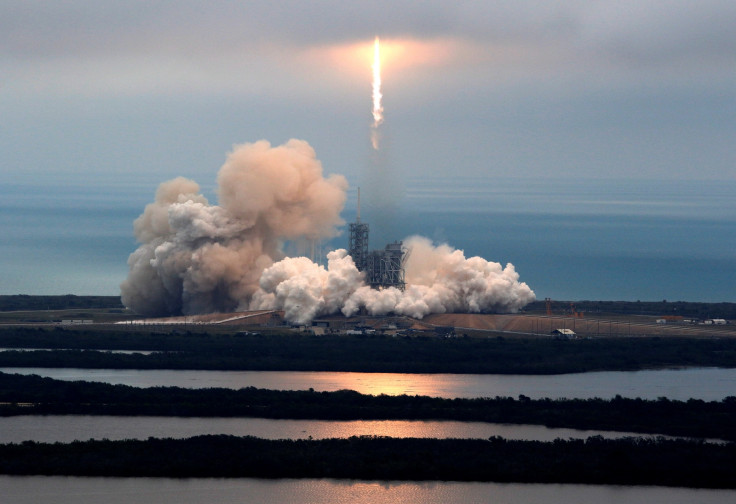SpaceX aborts second launch attempt for Intelsat 35e as Dragon capsule returns home
The second aborted launch came just hours after SpaceX successfully guided its Dragon capsule back to Earth.

SpaceX scrubbed the launch of a massive communications satellite for the second time in two days just 10 seconds before liftoff. The company's Falcon 9 rocket was scheduled to liftoff at 8:35PM EST on Monday (3 July) from the historic Launch Pad 39A at Nasa's Kennedy Space Center in Florida and deliver the nearly 15,000 lb Intelsat 35e to geostationary orbit.
Similar to the first launch attempt on Sunday, the rocket's on-board computers aborted the launch attempt at T-9 seconds. The first launch attempt was aborted due to an "out-of-limits" reading in the rocket's guidance and navigation system.
Although it seemed to be a repeat of the halted launch on Sunday night, John Insprucker, Falcon 9 principal integration engineer who hosted Monday night's webcast said SpaceX had fixed the technical glitch that suspended Sunday's launch attempt.
SpaceX said the second launch was scrapped "due to a violation of abort criteria", but noted that the vehicle and payload are in "good health." The Elon Musk-owned company will once again try to fire off the rocket on Tuesday, 4 July.
The company will not attempt to recover the first-stage rocket booster for reuse this time. Due to the Intelsat satellite's massive weight and its delivery into geostationary orbit, the rocket will not have enough fuel reserves to attempt a safe landing.
The scrubbed launches come just a week after SpaceX nailed its "doubleheader weekend" with the launch of two rockets from both coastlines on Friday and Sunday.
Standing down today due to a violation of abort criteria, vehicle/payload in good health, next launch opportunity tomorrow, July 4th!
— SpaceX (@SpaceX) July 4, 2017
Meanwhile, SpaceX successfully guided a Dragon capsule back to Earth from the International Space Station for the second time earlier on Monday.
The unmanned spacecraft, which was launched in early June, was first sent to the ISS back in September 2014 and was refurbished for a second resupply mission to transport 6,000 lb worth of supplies and experiments to the orbiting space station.
The previously used Dragon splashed down in the Pacific Ocean shortly after 8:00AM EST after a 5.5 hour journey back to Earth, carrying about 4,100 lb worth of cargo including samples, gear and other scientific experiments to be analyzed on Earth.
The samples include tissue from mice used in testing an osteoporosis drug that could potentially help future space crew members as it may help rebuild bone and block further bone density loss - a symptom of spending extended periods of time in space.
Good splashdown of Dragon confirmed—completing first re-flight of a commercial spacecraft to and from the @Space_Station.
— SpaceX (@SpaceX) July 3, 2017
Astronaut Jack Fischer also shared some stunning photographs of the Dragon in flight early Monday, including one image (embedded below) that captured the capsule reentering the Earth's atmosphere.
And there goes #Dragon… Goodbye to our 1st return visitor since Atlantis in 2011--Come on back anytime, we’ll leave the lights on for you! pic.twitter.com/D55Hg4yAhd
— Jack Fischer (@Astro2fish) July 3, 2017
Beautiful expanse of stars-but the “long†orange one is SpaceX-11 reentering! Congrats team for a successful splashdown & great mission! pic.twitter.com/m5rMnXYZ1g
— Jack Fischer (@Astro2fish) July 3, 2017
"Dragon's been an incredible spacecraft," Fischer said after the Dragon's release from the space station. "I could even say it was slathered in awesome sauce. This baby has had almost no problems, which is an incredible feat considering it's the first reuse of a Dragon vehicle.
"And the science we've done - oh my, the science. Most of the 6,000 pounds of cargo carried was science, and almost all the return cargo are precious samples for discoveries we can't wait to see."
The achievement comes as Musk has long championed the reuse of space hardware to significantly drive down the cost of launches.
Liftoff for the Intelsat 35e mission is scheduled for Tuesday, 4 July at 7:37PM EST (12:37AM BST on 5 July) with a 58-minute launch window. The satellite will be deployed approximately 32 minutes after launch. The launch will be streamed live on SpaceX's hosted webcast on YouTube.
© Copyright IBTimes 2025. All rights reserved.





















